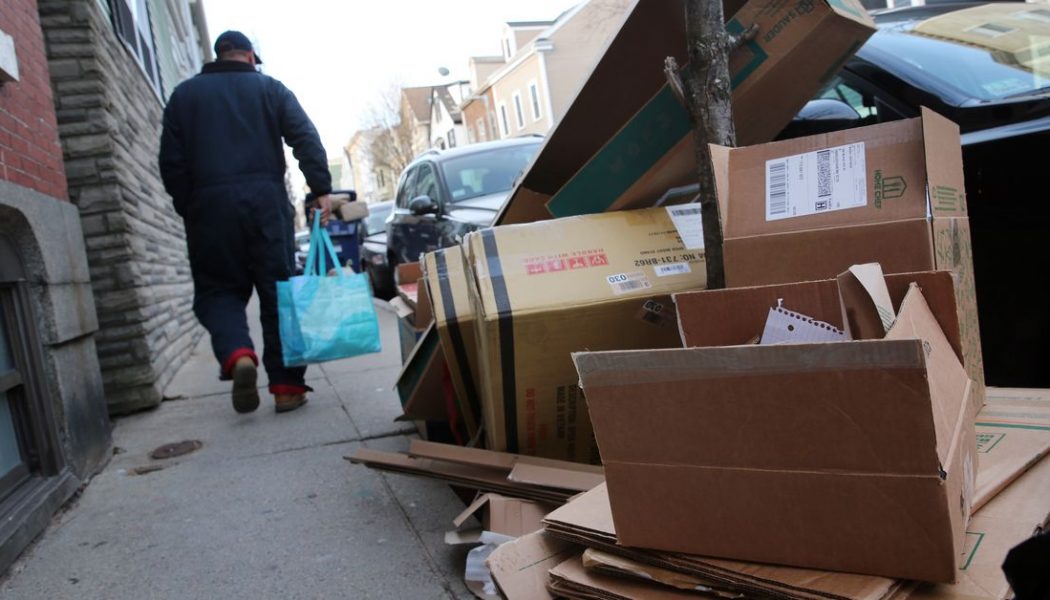
The fate of cardboard boxes in the US rests in the hands of consumers more than it ever has been before. In the past, brick-and-mortar retailers handled much of the leftover packaging from shipments. Malls and grocery stores usually send big bales of used but relatively clean cardboard to recycling programs so that they can be made into new boxes. Now, the rise of e-commerce, which started before the pandemic, has shifted more responsibility onto shoppers to properly dispose of boxes so that they can be recycled. Boxes are piling up on residential curbsides instead of at retail stores.
The pandemic has only accelerated this shift, which experts expect to continue even after COVID-19 is under control. One of the largest waste collection companies in the US, Republic Services, saw as much as a 25 percent increase in waste it picked up from households last year — after the volume it picked up from commercial customers dropped by up to 30 percent when pandemic-induced lockdowns began. The company says it’s even had to change its equipment so that it can capture smaller boxes from e-commerce in addition to the larger packaging used to send goods to stores.
When cardboard winds up at a person’s house instead of at a store, there’s a bigger chance that it could be tossed in the trash or otherwise become too dirty to recycle. “The concern is that when you have more [cardboard] transitioning to the home, it becomes more of an individual choice for consumers whether they recycle it,” says Rachel Kenyon, senior vice president at the Fibre Box Association, a trade group representing packaging manufacturers. “We really want to encourage consumers to recycle because we do need that fiber back. It does help us to make another box again.”
The corrugated cardboard used to ship the things people buy in stores and online is remarkably salvageable. Virgin cardboard can be recycled to make more of the same material up to seven times. Once the fiber degrades, it can be used to make paperboard, which is used in things like cereal boxes. The average box now contains about 50 percent recycled material, according to Kenyon.
Recycling is no substitute for cutting down on waste in the first place, and online retailer behemoths still have a lot of work to do on that front. But cardboard has a much higher recycling rate compared to other packaging materials. The overall recycling rate for materials, including paper, glass, and plastics, in the US was about 32 percent in 2018, according to the Environmental Protection Agency. The recycling rate for cardboard boxes, on the other hand, has hovered close to 90 percent since 2011. To keep those rates high, the cardboard industry will need shoppers to recycle the increasing number of boxes from the record amounts of box shipments made during the pandemic, according to Kenyon. By last November, the containerboard packaging industry saw a 3.6 increase in production, according to the American Forest & Paper Association.
There’s some indication that people are recycling their boxes in large numbers. Waste haulers, who can sell recovered cardboard to companies that make new boxes with it, saw a similar rise in cardboard over the past several months. Republic Services saw a 2 percent increase in the amount of cardboard it was able to sell in 2020, which it attributes to more e-commerce. That was a pretty significant bump considering monumental challenges that the recycling industry overall has seen in recent years.
Just a year ago, recycling was facing a crisis. There was too much cardboard flooding the system, and as a result, the price of cardboard had tumbled so low that recycling programs were suffering. Some municipal recycling programs closed up shop or even resorted to burning and dumping recyclables they couldn’t sell.
A big part of the problem was that the US had for years relied heavily on exporting a lot of its recyclables to China. In 2018, China began severely restricting imports. The recycling rate for cardboard dipped as the US figured out where else to send its trash and scrambled to build up its domestic recycling capacity.
In the past couple of years, new paper mills have already come online, and others are on the way, experts tell The Verge. The demand for more cardboard boxes — fueled by a pandemic-driven boom in e-commerce — is also helping once-struggling recycling programs stay afloat.
“We are recovering,” says David Biderman, executive director and CEO of the Solid Waste Association of North America. “If the economy continues to recover and more of this domestic capacity comes online later this year, I believe that this provides good tailwind for recycling.”
That doesn’t mean it will be all smooth sailing ahead. Up to 40 percent of Americans don’t have access to curbside receptacles for their recyclables, according to a 2016 study. In more rural areas, people might need to drop off their materials at recycling facilities.
Access isn’t the only issue with consumer recycling. Waste haulers are still finding all kinds of weird things in recycling bins that can cause problems. Unlike trash from brick-and-mortar stores, curbside recycling is often mixed up with other items from peoples’ homes and kitchens. Dirty diapers and half-full condiment bottles can contaminate cardboard, making it unfit for recycling. Holiday lights and batteries tossed into curbside recycling are also major headaches around this time of year. Holiday lights get tangled up in sorting equipment and can force recycling facilities to temporarily shut off their machinery. Batteries can become a fire hazard when mixed up with paper and cardboard.
“One of the things that keeps me awake at night is fire. There are a lot of batteries that are out there, post holiday season,” says Pete Keller, vice president of recycling and sustainability at Republic Services. “Education is very, very important to any successful recycling program, contamination in the US continues to be a bit of a challenge.”
“We also ask people to remove any non-paper packing materials, break boxes down flat, keep them dry and clean and place them in the bin,” Heidi Brock, president and CEO of the American Forest & Paper Association, said in an email to The Verge. “We need everyone to pitch in and do their part to recycle paper-based products at home.”










